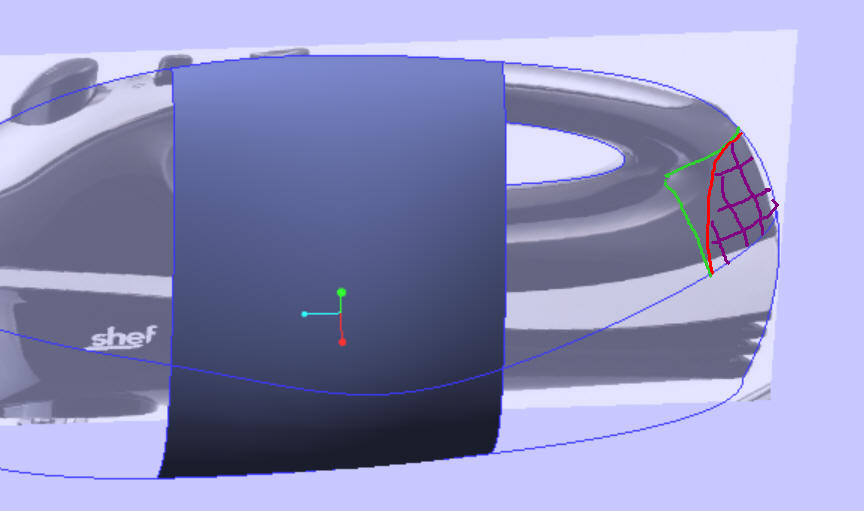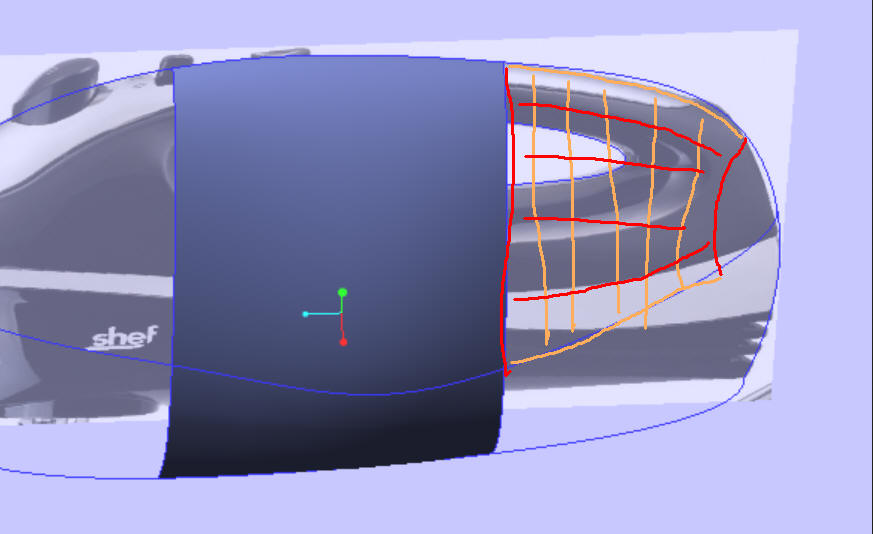Community Tip - You can change your system assigned username to something more personal in your community settings. X
- Community
- Creo+ and Creo Parametric
- 3D Part & Assembly Design
- Re: Style Tool Surfacing: Cannot Surface Corners
- Subscribe to RSS Feed
- Mark Topic as New
- Mark Topic as Read
- Float this Topic for Current User
- Bookmark
- Subscribe
- Mute
- Printer Friendly Page
Style Tool Surfacing: Cannot Surface Corners
- Mark as New
- Bookmark
- Subscribe
- Mute
- Subscribe to RSS Feed
- Permalink
- Notify Moderator
Style Tool Surfacing: Cannot Surface Corners
I have been banging my head against this problem for 5 hours now, any help would be greatly appreciated!
I am trying to surface the side of this kitchen mixer. I have my curves made in the style tool essentially making the side into a 3x2 grid, and attempting to fill each part of the grid with a surface (I need to do that so I can deal with the 3 sided surfaces). However, while the middle two fill easily, the corners refuse to work with the message "Curves define more than one surface. Known curve intersections are shown".
I've attached the part I'm working on, can anyone tell me what step I'm missing to getting a surface added in to these corners, or to just surface this whole side?
Thank You!!!!
This thread is inactive and closed by the PTC Community Management Team. If you would like to provide a reply and re-open this thread, please notify the moderator and reference the thread. You may also use "Start a topic" button to ask a new question. Please be sure to include what version of the PTC product you are using so another community member knowledgeable about your version may be able to assist.
- Mark as New
- Bookmark
- Subscribe
- Mute
- Subscribe to RSS Feed
- Permalink
- Notify Moderator
I cannot open the academic version file. Care to show a picture?
Have a you tried a simple corner round?
- Mark as New
- Bookmark
- Subscribe
- Mute
- Subscribe to RSS Feed
- Permalink
- Notify Moderator
That's odd, I wonder why that is?
Here is a side view: The bottom right is the one I'm trying now but all the corner peices don't work. (I know I need to do some fiddling around with the 3 sided patches to make them work properly).
Here's an angle view so you can see the shape of it.
Thanks!
- Mark as New
- Bookmark
- Subscribe
- Mute
- Subscribe to RSS Feed
- Permalink
- Notify Moderator
Take a look at boundary surface with tangency.
Full verions of Creo cannot open academic. This is normal for some silly reason.
- Mark as New
- Bookmark
- Subscribe
- Mute
- Subscribe to RSS Feed
- Permalink
- Notify Moderator
The reason is that the academic version is very inexpensive and PTC doesn't want companies buying it to do commercial work. It's cheap to encourage students to learn it and schools to adopt it.
- Mark as New
- Bookmark
- Subscribe
- Mute
- Subscribe to RSS Feed
- Permalink
- Notify Moderator
Somebody once made a compelling arguement for allowing us to at least open academic versions:
http://communities.ptc.com/ideas/2842
Thanks for trying Antonius!
- Mark as New
- Bookmark
- Subscribe
- Mute
- Subscribe to RSS Feed
- Permalink
- Notify Moderator
Try this:
1. create a little swept surface (var sec sweep, green boundary)
2. trim surface into quarter circle (extruded trim, or projected curce and trim, red boundary)
3. create four sided boundary surface (2nd image, red and orange boundary)
Avoid three sided patches. They often refuse to thicken and offset due to swinging curvature near the degenreted point (where the two boundaries in the same direction fall into a point)


- Mark as New
- Bookmark
- Subscribe
- Mute
- Subscribe to RSS Feed
- Permalink
- Notify Moderator
Have you considered using a Freestyle feature?
- Mark as New
- Bookmark
- Subscribe
- Mute
- Subscribe to RSS Feed
- Permalink
- Notify Moderator
That was my workaround, it did end up working for this project where dimensions weren't important.
- Mark as New
- Bookmark
- Subscribe
- Mute
- Subscribe to RSS Feed
- Permalink
- Notify Moderator
The fix ended up being splitting the centre (or the top) curves so that they no longer could define more than one surface. What a maddening problem! The freestyle feature worked in the meantime.
Thanks for the suggestions everyone!





